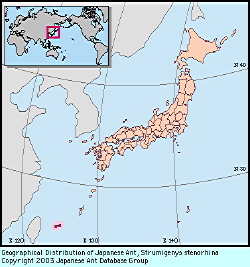
|
species
|
Strumigenys stenorhina
|
 |
Japanese Name
|
Kibanaga-uroko-ari
|
Original Reference
|
|
Bolton, B. (2000) The ant tribe Dacetini part 2. Memoirs of the American
Entomological Institute, 65: 492-1028.
|
Description
|
|
Total length of workers around 2 mm. Body color yellow to brown. Eyes large, each consisting of around 20 facets. Mandibles elongate, almost half as long as head; shafts stout and almost straight; apical forks without intercalary denticles; subapical teeth stout. Ventral outline of head weakly convex in profile. Infradental lamellae of propodeum thin, about half as broad as propodeal spines, without spongiform appendage. Mesopleuron and lateral portion of propodeum unsculptured, smooth and shining.
|
Remarks
|
|
The species is similar to Strumigenys exilirhina [Kibabuto-uroko-ari], but distinguished by its long, straight mandibles. Corresponding to Strumigenys sp. 5 (Myrmecological Society of Japan Editorial Committee, 1988), and S. sp. E. of Onoyama (1976). Nests under stones or decayed wood. Polygynous.
|
|

Distribution
|
|
Ishigaki I., Iriomote I., Yonaguni I.
|
|
References
|
|
- Onoyama, K. (1976). A preliminary study of the ant fauna of Okinawa-Ken, with taxonomic notes. (Japan: Hymenoptera: Formicidae). . Ecol. Stud. Nat. Cons. Ryukyu Isl., 2, 121-141.
- Myrmecological Society of Japan, Editorial Committee (ed.) (Ed.). (1988). A list of the ants of Japan with common Japanese names. The Myrmecological Society of Japan, Tokyo.
|
Editor
|
|
Original text by Kazuo Ogata, Keiichi Onoyama and Mamoru Terayama. English translation by Kazuo Ogata, edited by Robert W. Taylor. Rwvised by Masashi Yoshimura.
|
|